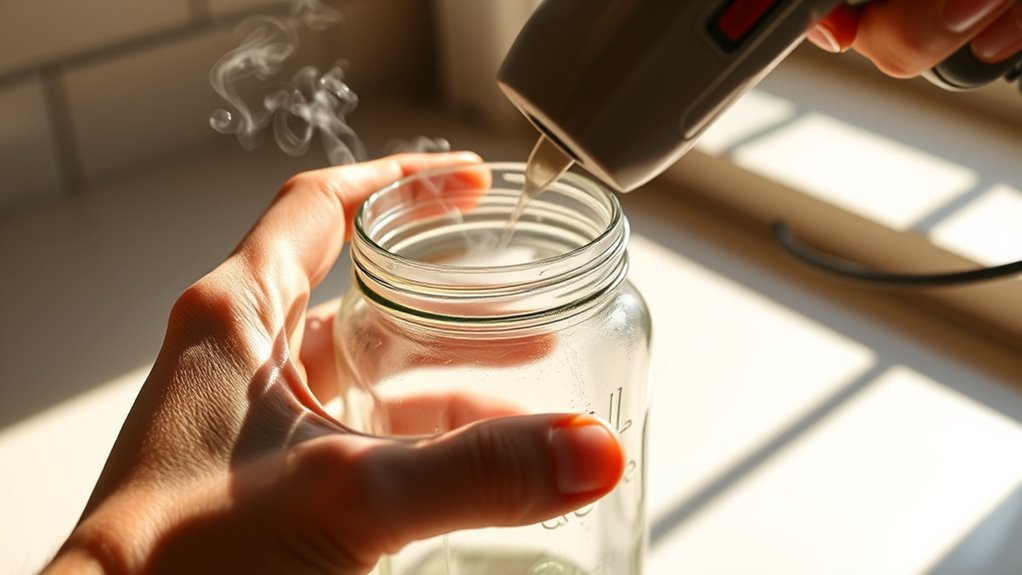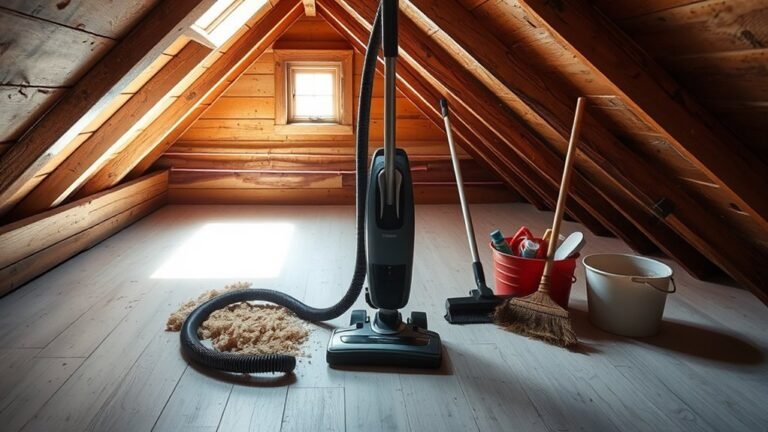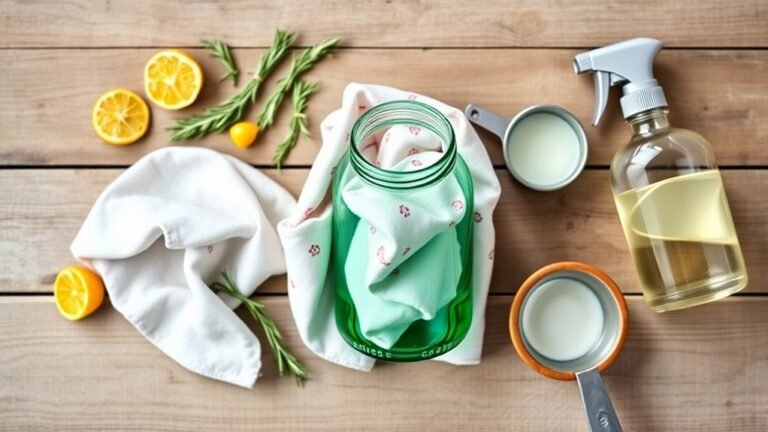Dealing With Sticky Labels on Glassware
Dealing with sticky labels on glassware can be frustrating, but you’ve got several simple options. Start by soaking your glassware in warm soapy water to soften the adhesive. If residue remains, apply vegetable oil or peanut butter and let it sit for a bit before rubbing it off. For tougher glue, rubbing alcohol or commercial removers work well. Avoid harsh scrubbing that can damage your glass. Keep going to explore more effective methods that make label removal easier and cleaner.
Understanding the Challenges of Sticky Labels

Although sticky labels might seem like a minor nuisance, they can pose real challenges when you’re trying to clean or reuse glassware. You’ll quickly notice that not all labels are created equal. Different label types come with varying adhesive properties, some designed to stick firmly, while others peel off more easily. These adhesives can leave behind stubborn residue, making your glassware look messy and frustrating your efforts to reclaim its original shine. Understanding these differences empowers you to tackle each label effectively, without damaging the glass or wasting time. When you know what you’re dealing with, you gain the freedom to choose the best removal method, ensuring your glassware is ready for whatever new purpose you have in mind.
Preparing Your Glassware for Label Removal
Now that you understand the different types of sticky labels and adhesives, it’s time to get your glassware ready for removal. First, gather your tools: a plastic scraper or old credit card, rubbing alcohol, and a clean cloth. Position your glassware on a stable surface to avoid accidents during the process. Before removing any labels, consider the labeling techniques used—some adhesives bond harder or soak in over time, so patience is key. Avoid harsh scrubbing that can damage the glass surface. Begin by gently loosening edges without scratching. Also, make sure your glassware is free from dust or grease by performing basic glass cleaning—this prevents additional residue buildup and helps adhesives loosen more effectively. Proper preparation sets you up for smooth, damage-free label removal.
Using Warm Soapy Water to Loosen Labels

When you soak your glassware in warm soapy water, the adhesive on the label begins to soften, making removal much easier. This soaking technique works well across various label types, from paper to plastic stickers. Just fill a basin with warm water and a few drops of dish soap, then submerge your glassware for 15 to 30 minutes. The warmth and soap break down the glue, freeing you from stubborn sticky residue without harsh chemicals. After soaking, gently peel or rub off the label with your fingers or a soft cloth. This simple, freeing method respects your desire for a clean surface without extra hassle. By mastering this soaking technique, you reclaim your glassware quickly and effortlessly, ready to enjoy or reuse it as you please.
Applying Oil-Based Solutions to Remove Adhesive
Two common oil-based solutions you can use to remove adhesive from glassware are vegetable oil and peanut butter. These oils break down the sticky label residue, making it easier to wipe away without harsh chemicals. For effective oil application, follow these steps:
Try vegetable oil or peanut butter to gently dissolve adhesive on glassware without harsh chemicals.
- Apply a generous amount of oil directly onto the label residue.
- Let it sit for 10-15 minutes to soften the adhesive.
- Use a cloth or your fingers to gently rub off the remaining residue.
This approach gives you freedom from stubborn glue without damaging your glassware. Plus, it’s simple and uses items you likely already have at home. Just remember to wash the glass thoroughly afterward to remove any oily film and enjoy your clean, label-free glassware.
Utilizing Heat Methods for Easier Label Peeling

When labels won’t budge, applying heat can help soften the adhesive for easier removal. You can soak your glassware in hot water or use a hair dryer to warm the label directly. Both methods loosen the glue, making peeling less frustrating.
Using Hot Water
A simple way to soften sticky labels on glassware is by soaking them in hot water. This method loosens the adhesive, making label removal much easier and less frustrating. Here’s how you can do it:
- Fill a basin with hot water—hot enough to help, but not so hot that you risk cracking the glass.
- Submerge the glassware, label side down, and let it soak for 10-15 minutes.
- Gently peel the label off; if any residue remains, rub it away with a cloth dipped in hot water.
Using hot water gives you freedom from stubborn labels without harsh chemicals or extra tools. It’s a straightforward, eco-friendly way to reclaim your glassware quickly and cleanly.
Applying a Hair Dryer
If soaking your glassware in hot water doesn’t fully loosen the label, you can try applying heat directly with a hair dryer. This method gives you control and freedom to target stubborn adhesive spots. Start by setting your hair dryer to a medium heat setting—too hot, and you risk damaging the glass or burning your fingers. Use steady, circular motions about 2–3 inches from the label, warming it evenly. The heat softens the glue, making peeling easier without harsh chemicals. Patience is key; repeat the hair dryer techniques as needed until the label loosens. Once softened, gently peel the label off, using a fingernail or plastic scraper. This simple heat method lets you reclaim your glassware effortlessly, freeing you from sticky residue with just a household tool.
Cleaning Residue With Alcohol or Commercial Adhesive Removers
Once you’ve peeled off the label, some sticky residue might still cling to your glassware. Choosing the right type of alcohol, like rubbing alcohol or isopropyl, can make a big difference in how easily that residue comes off. You can also try commercial adhesive removers, but it’s important to pick one that’s safe for glass and follow the instructions carefully.
Choosing the Right Alcohol
Wondering which type of alcohol works best for removing sticky label residue from glassware? When you’re enjoying a craft beer or picking from a wine selection, you want your glassware spotless without hassle. Here’s how to choose:
- Isopropyl Alcohol (Rubbing Alcohol): Ideal for tough residues; evaporates quickly and won’t leave a film.
- Denatured Alcohol: Strong and effective but use in a well-ventilated area because of its fumes.
- Ethanol (High-proof Drinking Alcohol): Safe and gentle, especially if you prefer a non-toxic option, though it can be pricier.
Picking the right alcohol lets you clean your glassware freely and efficiently, so you can fully enjoy your favorite drinks without sticky distractions.
Effective Adhesive Removers
Although sticky label residue can be stubborn, you’ve got effective options to tackle it using either alcohol-based solutions or commercial adhesive removers. Depending on the adhesive types used, some residues respond better to rubbing alcohol or isopropyl alcohol, which gently break down the glue without harming your glassware. If you prefer natural alternatives, try applying a bit of coconut oil or vinegar first; they soften residue and make scrubbing easier. For tougher adhesives, commercial removers provide targeted formulas that dissolve sticky remnants quickly, giving you more freedom to clean without endless scrubbing. Just make sure to test any remover on a small area to avoid damage. By choosing the right remover—whether natural or chemical—you reclaim your glassware’s clarity and enjoy the satisfaction of a residue-free finish.
Frequently Asked Questions
Can Sticky Labels Damage the Glassware Surface?
You might worry that sticky labels could damage your glassware surface, but usually, they don’t if you handle them right. The real issue is label residue, which can be stubborn but won’t harm the glass itself. To keep your glass protection intact, gently remove the residue using safe methods like warm soapy water or rubbing alcohol. This way, you maintain your freedom to reuse and enjoy your glassware without worry.
Are There Eco-Friendly Alternatives to Commercial Adhesive Removers?
You can definitely choose biodegradable solutions that won’t harm the environment or your freedom to live sustainably. Natural remedies like vinegar, baking soda, or lemon juice work wonders for breaking down adhesive without harsh chemicals. These eco-friendly options let you remove sticky residues guilt-free, keeping your glassware pristine while respecting the planet. You don’t have to rely on commercial removers when nature provides safe, effective alternatives you can trust.
How Long Should I Soak Glassware Before Label Removal?
When you’re trying to remove labels, your soaking duration really depends on the label types. Paper labels usually need about 10-15 minutes in warm, soapy water to loosen up. Plastic or waterproof labels might require longer—sometimes up to 30 minutes or more. Don’t rush it; giving the adhesive time to soften means less scrubbing and no damage to your glassware. Just soak, peel, and enjoy the freedom from sticky residue!
Can I Use Vinegar Instead of Alcohol for Residue Cleaning?
You can definitely use vinegar for residue cleaning, but its effectiveness varies compared to alcohol. Vinegar’s acidity helps break down sticky substances, making it a natural choice if you want to avoid harsher chemicals. However, alcohol usually works faster and leaves less oily residue behind. If you’re after freedom from stubborn glue, try vinegar first—it’s gentle and eco-friendly. If the residue persists, switch to alcohol for a quicker clean.
Is It Safe to Use a Hairdryer on All Types of Glassware?
Imagine you’re trying to remove a label from a delicate antique glass vase. Using a hairdryer might seem like a quick fix, but not all glass types handle heat the same. Some, like borosilicate glass, tolerate it well, but others, especially thin or old glass, can crack due to heat sensitivity. So, it’s safer to test on a small area first or stick to gentler methods to keep your glassware intact and enjoy freedom from damage.






